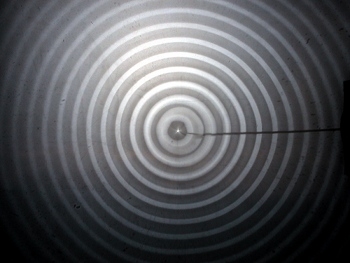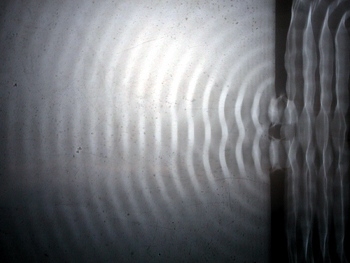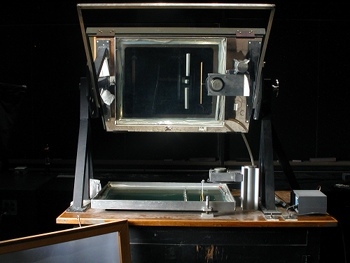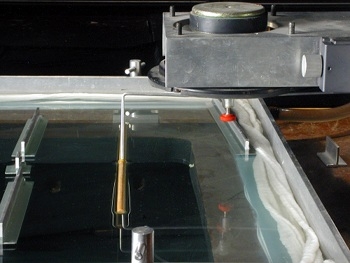Interference patterns of water waves generated by different sources at adjustable frequency.
 |
 |
What It Shows
Various wave phenomena demonstrated with water waves: circular waves from point sources, plane waves from an array of point sources, change of wavelength with frequency and/or speed, reflection of waves, refraction of waves, focusing of waves, standing waves, interference from point sources, interference and diffraction from apertures, obstacles, and barriers, phased arrays of sources (directional plane waves), beating phenomenon, doppler shift, and shock waves.
 |
 |
How It Works
A shallow, one square meter glass-bottomed tank is filled with a couple inches of water. A dipper, suspended from an 8 Ohm speaker driver, is partially submerged. When the driver is driven by a function generator, the dipper causes ripples in the water. To show these ripples, bright light from a xenon arc lamp shines through the tank's glass bottom, reflects off a one square meter front surface mirror, and illuminates a large, thin screen that hangs vertically.
The height of the driver above the water can be adjusted to accommodate different dippers. A sphere can be used as a point source. A horizontal dowel can produce coherent parallel wavefronts. Several variations exist.
Obstacles can be placed to interact with the rippling water; a single barrier can show edge diffraction; multiple barriers can show sinlge or multi-slit patterns; a triangluar peice of plexiglass acts as a prism; a convex peice brings the wavefronts to a focus.
Setting It Up
The apparatus is large and heavy. Extra time should be allowed for wheeling it into a hall. The mirror and screen can block a significant portion of the blackboard, so if one plans to use the boards the apparatus should be placed off to the side. The angle of the mirror should be adjusted so that the entire tank is visible on the screen. Make sure the entire class can view the image on the screen.
Once the apparatus is set in position, fill the tank with about an inch of water. Place absorbent rags along the perimeter of the tank to prevent unwanted reflections. When preparing for a demonstration of refraction, use the leveling scews near each edge of the tank to make sure it is perfectly level, and be careful to add just enough water to cover the inserted plastic. After use the water can be drained through a hose attached to one of the corners of the tank.
The dipper should be only partly submerged. Adjust the height of the driver as necessary. Start by driving the dipper at a small amplitude and slowly increase it until distortion or splashing occurs, and then back it off from that point. Higher frequencies will generally cause distortion with less amplitude, so sweeping up in frequency should be compensated by reducing the amplitude slightly.
The xenon arc lamp requires a fan to keep it cool, and should always be running when the lamp is on.
Comments
Although other demonstrations that use light and sound can produce more obvious results of various wave phenomena, the Ripple Tank excels at illustrating why they occur.
Some of the demonstrations are visually subtle, so the lecture hall lights should be turned off for best viewing.